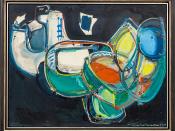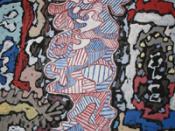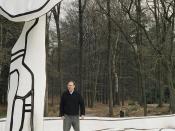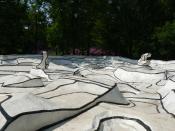DubuffetÃÂs Trash The artist and work chosen for this paper is Jean Dubuffet and the work is Volonte de puissance. There will be four methodological approaches to analyze the work. The first will be from a formalist perspective, second a psychoanalytical perspective, third a social art historical perspective, and fourth a semiotic perspective. I will analyze the work and come to solid conclusions with the help of articles written about the piece by art historians and critics. A reference copy of the artwork can be found at the end of the semiotic perspective.
The formalism of the painting done by Dubuffet is one of a revolutionary quality. It sticks to the formalist ideas of famed critic Clement Greenberg only by ÃÂcoexisting with the flatness of the picture plane, extend to its outer edges as if the flesh were spread over its surface with a butter knife.ÃÂ (DÃÂSouza). The flesh that is spread over the canvases surface however is another issue of concern for Greenberg.
The flesh of the figure is made of base materials, in this case the base material is dirt, and dirt according to Greenberg is not a ÃÂproperty essential to its mediumÃÂ thus inferring to the ÃÂimpurityÃÂ of the artwork and does not fit into his formalism (Afterimage). His figure in the painting is of the primitive nature and rejects the formalist ideas of aesthetics by blurring the lines between beauty and ugliness (DÃÂSouza). Dubuffet further rejected the ideas of Greenberg formalism by not being flat; this work lifts off the canvasÃÂs surface and becomes sculpture like and sculpture is not ÃÂintrinsic to paintingÃÂ what is intrinsic to painting is ÃÂits flat surfaceÃÂ (Mack).
ÃÂWithout the past of art, and without the need to maintain past standards of excellence, such a thing as Modernist art would be impossibleÃÂ-Clement Greenberg, what I get out of this quote by Greenberg is that art like that of the Dubuffet piece being analyzed is regressive instead of progressive. I disagree. Instead I believe that the piece by Dubuffet serves to bring things down in the world, more relatable and human, that it ÃÂaims to collapse the artificial distinctions that have been imposed on the base materialÃÂ and offers a new definition of formalism (Shane).
I mean a new definition of formalism because the piece by Dubuffet, who is an avant-garde artist, entered into the gallery. Once something enters the gallery and is hung on the walls it becomes art. Thus the dirt is no longer dirt it is art, an artwork ready to become a commodity and sold. Meaning that since the piece, which consists of dirt has become art, it can now have its formal qualities recorded and mimicked by other artists i.e. Rauschenberg (Shane).
In conclusion formalism is ever changing with each new radical artwork that is brought into the gallery and hung on the walls, from ready-mades to dirt. It is ridiculous to try and contain/draw boundaries on what should and should not be considered art. It has been shown through time that the offensive and repulsive is a way for artist to get attention to their cause and their being either expressionistically or intentionally and enter the gallery. What is left is a new art form ready for other artists to mimic and expand, a new formalism for a new kind of art.




